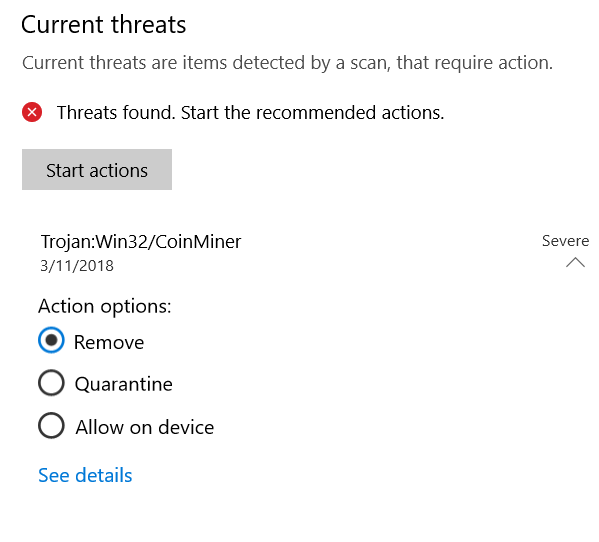Win32.CoinMiner Removal Guide (Threat Description)
What is Win32.CoinMiner
Win32.CoinMiner, also knowns as simply CoinMiner, is a malware that uses the infected computer’s resources to mine for cryptocurrency. It’s not the most dangerous computer infection because it does not steal information, delete files and do anything besides mine. However, the mining is a very annoying feature and causes a lot of inconvenience. It essentially uses your computer’s resources to mine for cryptocurrency, while your computer starts acting strangely due to its resources overused.

Generally, mining malware symptoms include slow computer, programs taking ages to launch and once they do, they crash constantly, and generally weird behaviour. Users aware of how their computers behave normally will notice these signs immediately. The most telling sign, however, is a process using a lot of your computer’s CPU. If you go to Task Manager and see a process using more than 30-40% of your CPU, that is suspicious. Some mining malware use up to 90%. This can have negative consequences in the future because prolonged high usage can lead to a shortened CPU lifespan.
While it may not seem like the most malicious infection out there, the sooner you remove Win32.CoinMiner the better. There are no reasons why you should allow cyber crooks to use your computer to make money.
How does cryptomining malware enter a computer?
Cryptomining malware can enter computers via the usual ways. You may have opened a malicious email attachment, downloaded something from an unsecure source, etc.
One of the most common ways malware enters a computer is via malicious email attachments. Spam emails are distributing all kinds of malware, and opening the attached file is enough to initiate the infection. This is why it’s always a good idea to be careful with unsolicited emails that contain attachments or links. You should always first check who the email is from, whether the sender is legitimate and who they say they are. If the email is supposed to be official correspondence, check for grammar and spelling mistakes. No actually official email will ever contain mistakes. Finally, even if everything else checks out, it’s a good idea to scan the file with anti-malware software or VirusTotal. Unless you are completely sure it’s safe, you should not open any unsolicited email attachments.
Users also often download malware when they’re downloading content from unsecure sources. This is particularly common in torrents for copyrighted content. An illegally available episode of a popular TV series or film may actually conceal dangerous malware. It’s not without reason that users are advised to be careful if they’re using torrents.
Downloading software cracks also often leads to a malware infection. Crack websites and forums are full of all kinds of infections. So if you download software cracks, you’re not only stealing but also putting your computer and your files in danger.
What does Win32.CoinMiner do?
As soon as the malware is initiated, it will start using your computer’s resources to mine for cryptocurrency. This will immediately become obvious because programs will lag and launch very slowly, and your computer will become sluggish. Your Task Manager will also display a process that uses up to 90% of your CPU. The slowness of your computer is the main issue because miners don’t exactly do any damage to the system. However, like we said above, you should not allow the infection to remain because it could damage your CPU.
Cyber crooks behind this mining malware make profit from using your computer’s resources, and you should not allow that.
Win32.CoinMiner removal
Fortunately, most anti-malware programs will detect the infection immediately. The infection may be detected as Win32.CoinMiner.EE, Win32.CoinMiner.DV, Win32.CoinMiner.BB, etc.
Scan your computer with reliable anti-malware and remove Win32.CoinMiner if it comes up. We do not recommend manual Win32.CoinMiner removal because you may miss something or end up doing more damage.
After the infection is gone from your computer, you should no longer experience any sluggishness or unusual behaviour. In short, everything should go back to normal. However, we do recommend that you leave your anti-malware running at all times to detect any future infections.
Site Disclaimer
WiperSoft.com is not sponsored, affiliated, linked to or owned by malware developers or distributors that are referred to in this article. The article does NOT endorse or promote malicious programs. The intention behind it is to present useful information that will help users to detect and eliminate malware from their computer by using WiperSoft and/or the manual removal guide.
The article should only be used for educational purposes. If you follow the instructions provided in the article, you agree to be bound by this disclaimer. We do not guarantee that the article will aid you in completely removing the malware from your PC. Malicious programs are constantly developing, which is why it is not always easy or possible to clean the computer by using only the manual removal guide.
